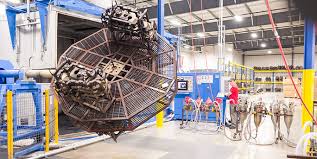Rotational molding, also known as rotomolding is a flexible and economical manufacturing method to create hollow plastic components. This method is favored for its capability to produce complex designs with uniform wall thicknesses, and with very little waste material. This is a complete guide to understanding Plastics Rotomolding as well as its benefits.
What is Rotomolding?
Plastics Rotomoldingis a thermoplastic processing technique used to produce seamless, hollow plastic parts. It involves three primary phases: heating, rotating, and cooling. Initially, plastic resin powder is placed into the mold. The mold is then heated in an oven, while moving along two perpendicular axes. This rotation ensures the powder evenly coats the inside of the mold. When the mold cools, the powder solidifies to form the final shape.
Materials Used
The most commonly used material for rotomolding is polyethylene it comes in various varieties, including high-density polyethylene (HDPE) as well as low density polyethylene (LDPE). Other materials, like polypropylene or polyvinyl chloride (PVC) and nylon, may be utilized based on the properties desired by your final item. Each material has its own advantages like flexibility, impact resistance, or chemical resistance.
Advantages of Rotomolding
The flexibility of design: Rotomolding allows for the creation of complex forms as well as intricate features. The process is able to create components with different wall thicknesses, inner structures and integrated features such as bosses or ribs.
Uniform wall thickness: Contrary to other molding techniques for plastic that use rotomolding, it ensures a consistent wall thickness throughout the piece. This helps to achieve more strength and longer durability.
Cost-Effectiveness: This process is economical, especially for large, hollow parts. The tooling costs are lower than injection molding due to the fact that molds are often made from aluminum, or other lesser expensive materials.
Minimal Waste: Rotomolding generates minimal material waste. Material that is not used is recyclable or reused, making it an environmentally friendly option.
Durability and Strength: Parts made by rotomolding are renowned for their toughness and resistance to impact and environmental elements. This makes them ideal for applications in harsh conditions.
Applications
Rotomolding is utilized in a myriad of industries and uses. The most common products are the storage tank, auto parts playground equipment, kayaks, and even custom containers. The versatility of the process allows it to be used for industrial and consumer goods.
Conclusion
Rotomolding is a durable and adaptable manufacturing technique which offers many advantages when creating hollow plastic components. Its ability to make complicated shapes, keep a an even wall thickness and reduce waste, rotomolding remains an ideal choice for a variety of applications. Knowing this process as well as its benefits can help manufacturers and designers make informed choices about using this technology for their plastic products.
